CURIOSITIES
ENGLAND
- Chesterton-UK – Vercelli-I The 9th C Vercelli Book contains a summary of the life of St. Guthlac, member of the Mercia royal family and hermit for 15 years at Crowland (Cambridge) from 698. In the 11th century, the codex, perfectly preserved, was brought by a pilgrim to Vercelli (Piedmont), where he must have died on his way to Rome. The codex in Old English was compiled in the late 10th C and contains 23 homilies and 6 poems (2 bear the signature of the poet Cynewulf in the form of enigmatic characters). Unknown for almost 1,000 years, the codex was discovered accidentally in 1822 by a German jurist. It is one of a group of four major anthologies of Old English literature.
- Il libro che visse due volte – storia, mito e legenda by Gianna Baucero Ed. Mercurio 2010
- In viaggio con il cardinale-Guala Bicchieri in Inghilterra (1216-1218) by Gianna Baucero Ed. Saviolo 2008
FRANCE
-
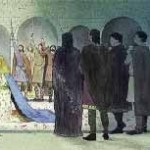
-
Mariage de Thierry fils de la Reine Brunhaut
-
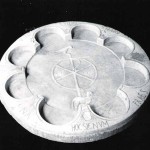
-
Besançon
- La Chaussée Brunehaut (G. Caselli) In the second half of the sixth century Brunnhilde settled on the Merovingian throne of Burgundy as regent for her young grandson Thierry (Theodoric). The queen was famous for her intrigues and malice and was in sharp conflict with St. Columbanus, the Irish preacher who was working to convert and moralize Merovingian Gaul and its rulers. The queen was killed in 613 by Clotaire II. Thierry founded the nunnery of St. Martin near the abbey of Saint-Maurice-CH (closed to women). A curious tradition that concerns Brunehilde (or “Brunnhilde” for the French) survives in northern France. Long straight stretches of VF in Artois, Picardy and Burgundy, are called, even on modern maps, Chaussée Brunehaut, and curiously match the courses of the ancient Roman roads. Popular tradition tells that after the death of her husband, Julius Caesar (!!), Brunnhilde would continue the work of the conqueror of Gaul and continued the construction of several roads.
- Besançon St James statue in a niche on Grande Rue. 9th C circle alter in St-Jean Cathedral
SWITZERLAND
-
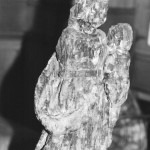
-
Bourg St-Pierre
-
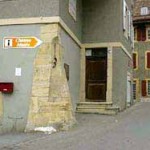
-
La Sarraz
-
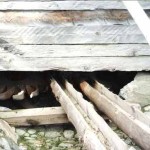
-
Verbier
-

-
Orsieres
- Lamentation of a tired pilgrim Variations on the theme of A.T., great explorer of the 20/21st centuries Marco Botta , Lausanne 4.8.2004
Chi lascia la vecchia strada per la nuova, sa quel che perde e non sa quel che trova. Chi lascia la nuova strada per la vecchia, solo s’arritrova e a molti guai s’apparecchia. Chi lascia la nuova strada per la vecchia, tutt’occhi ha da stà e appizzar la recchia. Chi lascia la nuova strada per la vecchia, invece di ber, getta l’acqua e la secchia. Chi lascia la nuova strada per la vecchia, cessa d’esse ape regina e torna a esse pecchia. Chi lascia la nuova strada per la vecchia, di gran coraggio ha bisogno e di pazienza parecchia
- La Sarraz-VD Saint Antoine chapel – Jaquemart: a tomb with reclining figure of Francis 1st of La Sarraz devoured by hideous beasts, surrounded by his widow, his daughter and his sons at arms. The last stocks in French-speaking Switzerland, opposite the church, where counterfeiters, wine, oil or butter falsifiers and women adulterers were put on display for two hours.
- Verbier Village-VS 17th C mill with horizontal wheel
- Bourg-St-Pierre-VS Wooden sculpture of Madonna and child from Lorette’s chapel and found after many years in the river…
- Orsières-VS The grotto where St Mayeul (Abbot of Cluny 10th C) was held captive for 6 months
ITALY
-
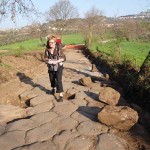
-
Montefiascone
-
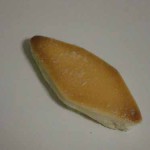
-
Dolce di Sidone
-

-
Labirinti sulla VF
- Montefiascone – Roman via Cassia on repair Labirinti sulla VF Montefiascone-Lazio Roman road under repair 7.2010
- Roma, Lucca, Pontremoli, Piacenza, Pavia Labirinths on the VF as symbols of medieval pilgrimage
VATICAN
 Sistine Chapel: A pilgrim’s stick with which Pope Julius II perportedly tried to strangle Michelangelo?
Sistine Chapel: A pilgrim’s stick with which Pope Julius II perportedly tried to strangle Michelangelo?
SAINTS on the VF
Copyright 2015 Association Internationale Via Francigena | All Rights Reserved |
Disclaimer | Credits:
Andrea Biello

 Sistine Chapel: A pilgrim’s stick with which Pope Julius II perportedly tried to strangle Michelangelo?
Sistine Chapel: A pilgrim’s stick with which Pope Julius II perportedly tried to strangle Michelangelo?